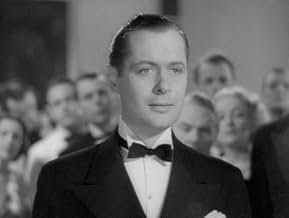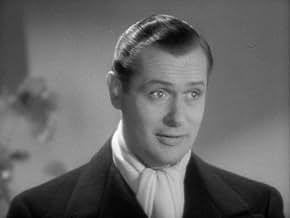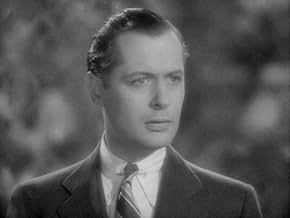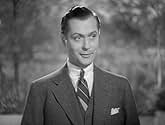AVALIAÇÃO DA IMDb
6,0/10
988
SUA AVALIAÇÃO
Adicionar um enredo no seu idiomaA society girl tries to reform her playboy husband by making him jealous.A society girl tries to reform her playboy husband by making him jealous.A society girl tries to reform her playboy husband by making him jealous.
- Direção
- Roteiristas
- Artistas
- Prêmios
- 3 vitórias no total
Charles Ruggles
- Edgar
- (as Charlie Ruggles)
Joan Fontaine
- Caroline
- (as Joan Burfield)
John David Horsley
- Duffy
- (as David Horsley)
E.J. Babille
- Desk Clerk
- (as E.J. Babiel)
Jean Acker
- Nightclub Extra
- (não creditado)
Gertrude Astor
- Nightclub Extra
- (não creditado)
Clem Beauchamp
- Drunk
- (não creditado)
Brooks Benedict
- Joe Williams - Bar Owner
- (não creditado)
Veda Buckland
- Marcia's Maid
- (não creditado)
Avaliações em destaque
The unoriginal plot, about a rich married couple dealing with problems of infidelity, is secondary here to the clever dialogue by Donald Ogden Stewart, who wrote the screenplay to The Philadelphia Story, and to a strong supporing cast. Joan Crawford is fine, but Robert Montgomery and Franchot Tone, fighting for Crawford's hand, wind up being nearly indistinguishable from each other, both in looks and in character. That leaves the supporting cast to rescue the film: Charles Ruggles has a fun bit as a slurring drunk and Arthur Treacher comes in at the end as a stuffy Brit who mumbles loudly and misuses American slang. Even Gail Patrick, who isn't normally given much to do in her man-stealing parts, is fine here. But the best is Edna May Oliver, playing the wise and witty matriarch--she steals every scene she's in and was the main reason I finished watching the movie.
You've seen it all before, folks--another tiresome romantic comedy, unredeemed by an accomplished cast and the trademark MGM gloss. Joan Crawford is especially wasted in the airy proceedings; her dramatic intensity has no outlet here, and she is forced to rely on her lesser skills as a sophisticated comedienne. This is Carole/Claudette/Irene territory, and, although Joan can give these ladies cards in spades when it comes to glamour, she lacks their lighter touch. I suspect two forces were at work here: the Production Code of 1933, which forced out earthy drama and bawdy comedy and pushed stars like Harlow and Crawford into fluff, and the "Norma" syndrome at MGM, which forced Crawford to take Norma's castoff parts. (No wonder Joan ended up "box-office poison" shortly after pictures like this alienated her fan base!) If you'd like to see Joan in comedies more suited to her persona, check out her splendidly bitchy Crystal in "The Women", or as the clueless Susan in "Susan and God".
Though the careers of Robert Montgomery, Joan Crawford, and her husband at the time, Franchot Tone's respective careers were not hurt by films like No More Ladies, this was the kind of stuff all three of these players were looking to get out of.
There was a truism at MGM back in its heyday. For films where the men wear tuxedos you first get Robert Montgomery. If he turns it down get Franchot Tone. If it's bad enough for Tone to turn it down God help him, Robert Young is stuck with it. So knowing the pecking order and knowing the billing, you can guess who Crawford winds up with.
Robert Montgomery plays another of those irrepressible womanizing playboys who's sowed enough wild oats to qualify for a farm subsidy. He's decided to settle down with society girl Joan Crawford who has certain ideas about infidelity and how wrong it is. Montgomery behaves at first, but when he uses their perpetually inebriated friend Charlie Ruggles as an alibi that doesn't hold up, Crawford decides on some revenge with Franchot Tone.
No More Ladies is harmless enough and when Edna May Oliver as Joan's grandmother is on the screen, always entertaining. But it was the stuff that MGM was grinding out in its dream factory. It was a case of Montgomery and Tone look great in tuxedos so cast them as urban playboys.
Well, both of them did look great, Louis B. Mayer wasn't wrong about that.
There was a truism at MGM back in its heyday. For films where the men wear tuxedos you first get Robert Montgomery. If he turns it down get Franchot Tone. If it's bad enough for Tone to turn it down God help him, Robert Young is stuck with it. So knowing the pecking order and knowing the billing, you can guess who Crawford winds up with.
Robert Montgomery plays another of those irrepressible womanizing playboys who's sowed enough wild oats to qualify for a farm subsidy. He's decided to settle down with society girl Joan Crawford who has certain ideas about infidelity and how wrong it is. Montgomery behaves at first, but when he uses their perpetually inebriated friend Charlie Ruggles as an alibi that doesn't hold up, Crawford decides on some revenge with Franchot Tone.
No More Ladies is harmless enough and when Edna May Oliver as Joan's grandmother is on the screen, always entertaining. But it was the stuff that MGM was grinding out in its dream factory. It was a case of Montgomery and Tone look great in tuxedos so cast them as urban playboys.
Well, both of them did look great, Louis B. Mayer wasn't wrong about that.
Broadway must have had dozens of these drawing room comedies featuring rich, well-dressed people speaking snappily to one another. I say "must have" because Hollywood seems to have adapted all of them. "No More Ladies" is yet another one, and for my money, it's pretty routine. Joan Crawford is a rich girl in love with a cad, played by Robert Montgomery. They marry and he's still a cad. In fact, instead of going to their country house one weekend, he delays his trip and has a dalliance with a woman named Therese. He admits this when he finally shows up in the country. He has little choice when he learns that his alibi, Charlie Ruggles, is actually at the country home. In retaliation, Crawford invites an old beau and a couple of ex-girlfriends to a huge party.
The dialogue is witty, the clothes are glamorous, the apartment and house are sumptuous, and the performances are very good. Montgomery was always perfect in these roles, and Crawford is attractive and spars with Montgomery well. Edna Mae Oliver is superb as always. Charles Ruggles plays a somewhat annoying drunk. Gail Patrick, who became Gail Patrick Jackson and produced "Perry Mason," having married Erle Stanley Gardner's agent, does very well as the pretty other woman.
This is one of those films where one asks, so why wasn't I crazy about it? The only reason is that there was a sameness about it and nothing really to differentiate it - including the cast - from all the other light, romantic comedies. It's no wonder that Robert Montgomery fought so hard to make "Night Must Fall." He was incredibly bored with these roles. It's understandable.
The dialogue is witty, the clothes are glamorous, the apartment and house are sumptuous, and the performances are very good. Montgomery was always perfect in these roles, and Crawford is attractive and spars with Montgomery well. Edna Mae Oliver is superb as always. Charles Ruggles plays a somewhat annoying drunk. Gail Patrick, who became Gail Patrick Jackson and produced "Perry Mason," having married Erle Stanley Gardner's agent, does very well as the pretty other woman.
This is one of those films where one asks, so why wasn't I crazy about it? The only reason is that there was a sameness about it and nothing really to differentiate it - including the cast - from all the other light, romantic comedies. It's no wonder that Robert Montgomery fought so hard to make "Night Must Fall." He was incredibly bored with these roles. It's understandable.
This is a film that came between two of Joan Crawford's best work in the movies, while still employed by MGM, "Grand Hotel" and "The Women". This is a film seldom seen these days. Thanks to TCM we had the opportunity to watch it.
In fact, "No More Ladies", is an adaptation of a stage play. Even though George Cukor was not given credit for helping Edward Griffith with the direction, the adaptation can't circumvent the fact one is watching a theatrical play the way it unfolds on the screen. Donald Ogden Stewart, a talented screen writer is among the several people that collaborated with the script. The problem with the screen play is that if feels too artificial.
The film is worth a look because of the star turn by Edna May Oliver, who as Fanny, steals the picture from its principals. Although not a radiant beauty, Ms. Oliver makes her presence known from the start because of her wit and the lines she delivers with absolute conviction and flair. As Neil Doyle has commented in this page, Ms. Oliver is the best thing in the film.
Joan Crawford is Marcia, the rich girl in love with Sherry, a man who has an eye for beautiful women and who doesn't mind straying. Ms. Crawford, dressed by Adrian, shows she had a way to show herself at an advantage in front of the camera, who loved her features, but somehow she comes across as too remote and she doesn't seem to have too much chemistry with her co-star.
Robert Montgomery plays Sherry, the man who can't keep away from women, as is the case when he meets Theresa, an attractive girl about town who couldn't care less if he belongs to another. Mr. Montgomery was an actor well suited for this type of comedy. He is always effective in the characters he portrays in film.
The supporting cast is interesting. Gail Patrick is perfect as Theresa, a role she was always good at portraying. Franchot Tone and especially Charles Ruggles, are seen at their best. This film marked the debut of Joan Fontaine, billed as Joan Burfield, in a small part.
"No More Ladies" is a curiosity film made more enjoyable by the presence of Edna May Oliver.
In fact, "No More Ladies", is an adaptation of a stage play. Even though George Cukor was not given credit for helping Edward Griffith with the direction, the adaptation can't circumvent the fact one is watching a theatrical play the way it unfolds on the screen. Donald Ogden Stewart, a talented screen writer is among the several people that collaborated with the script. The problem with the screen play is that if feels too artificial.
The film is worth a look because of the star turn by Edna May Oliver, who as Fanny, steals the picture from its principals. Although not a radiant beauty, Ms. Oliver makes her presence known from the start because of her wit and the lines she delivers with absolute conviction and flair. As Neil Doyle has commented in this page, Ms. Oliver is the best thing in the film.
Joan Crawford is Marcia, the rich girl in love with Sherry, a man who has an eye for beautiful women and who doesn't mind straying. Ms. Crawford, dressed by Adrian, shows she had a way to show herself at an advantage in front of the camera, who loved her features, but somehow she comes across as too remote and she doesn't seem to have too much chemistry with her co-star.
Robert Montgomery plays Sherry, the man who can't keep away from women, as is the case when he meets Theresa, an attractive girl about town who couldn't care less if he belongs to another. Mr. Montgomery was an actor well suited for this type of comedy. He is always effective in the characters he portrays in film.
The supporting cast is interesting. Gail Patrick is perfect as Theresa, a role she was always good at portraying. Franchot Tone and especially Charles Ruggles, are seen at their best. This film marked the debut of Joan Fontaine, billed as Joan Burfield, in a small part.
"No More Ladies" is a curiosity film made more enjoyable by the presence of Edna May Oliver.
Você sabia?
- CuriosidadesBig-screen debut of Joan Fontaine (listed as Joan Burfield).
- Erros de gravaçãoWhen Sherry and Fanny are talking in front of the fireplace, from one scene to the next his position changes back and forth. First he's standing and facing Fanny, who is sitting as they talk; then he is to her side, kneeling on a sofa bench with his back to her and leaning on the fireplace hearth. Then he is back opposite her, standing and facing her as they talk; then he's back kneeling on the sofa and leaning on the hearth. Then he's once again standing and facing Fanny.
- Citações
Oliver Allen: Look here, you can't go up there--she might be in bed!
Sheridan 'Sherry': Since when has a lady in bed been an object of repugnance?
- ConexõesFeatured in Joan Crawford: The Ultimate Movie Star (2002)
- Trilhas sonorasAll I Do Is Dream Of You
(1934) (uncredited)
Music by Nacio Herb Brown
Lyrics by Arthur Freed
Played on banjo by Arthur Treacher and
Sung by Gail Patrick at the party
Principais escolhas
Faça login para avaliar e ver a lista de recomendações personalizadas
Detalhes
- Data de lançamento
- País de origem
- Idioma
- Também conhecido como
- No More Ladies
- Locações de filme
- Empresa de produção
- Consulte mais créditos da empresa na IMDbPro
Bilheteria
- Orçamento
- US$ 765.000 (estimativa)
- Tempo de duração1 hora 20 minutos
- Cor
- Proporção
- 1.37 : 1
Contribua para esta página
Sugerir uma alteração ou adicionar conteúdo ausente

Principal brecha
By what name was Adeus Mulheres (1935) officially released in India in English?
Responda


































